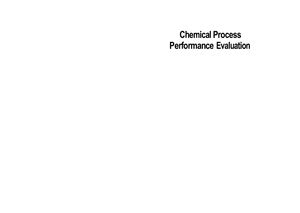CRC Press. 2007. 310p.
The latest advances in process monitoring, data analysis, and control systems are increasingly useful for maintaining the safety, flexibility, and environmental compliance of industrial manufacturing operations. Focusing on continuous, multivariate processes, Chemical Process Performance Evaluation introduces statistical methods and modeling techniques for process monitoring, performance evaluation, and fault diagnosis. This book introduces practical multivariate statistical methods and empirical modeling development techniques, such as principal components regression, partial least squares regression, input-output modeling, state-space modeling, and modeling process signals for trend analysis. Then the authors examine fault diagnosis techniques based on episodes, hidden Markov models, contribution plots, discriminant analysis, and support vector machines. They address controller process evaluation and sensor failure detection, including methods for differentiating between sensor failures and process upset. The book concludes with an extensive discussion on the use of data analysis techniques for the special case of web and sheet processes. Case studies illustrate the implementation of methods presented throughout the book. Emphasizing the balance between practice and theory, Chemical Process Performance Evaluation is an excellent tool for comparing alteative techniques for process monitoring, signal modeling, and process diagnosis. The unique integration of process and controller monitoring and fault diagnosis facilitates the practical implementation of unified and automated monitoring and diagnosis technologies.
The latest advances in process monitoring, data analysis, and control systems are increasingly useful for maintaining the safety, flexibility, and environmental compliance of industrial manufacturing operations. Focusing on continuous, multivariate processes, Chemical Process Performance Evaluation introduces statistical methods and modeling techniques for process monitoring, performance evaluation, and fault diagnosis. This book introduces practical multivariate statistical methods and empirical modeling development techniques, such as principal components regression, partial least squares regression, input-output modeling, state-space modeling, and modeling process signals for trend analysis. Then the authors examine fault diagnosis techniques based on episodes, hidden Markov models, contribution plots, discriminant analysis, and support vector machines. They address controller process evaluation and sensor failure detection, including methods for differentiating between sensor failures and process upset. The book concludes with an extensive discussion on the use of data analysis techniques for the special case of web and sheet processes. Case studies illustrate the implementation of methods presented throughout the book. Emphasizing the balance between practice and theory, Chemical Process Performance Evaluation is an excellent tool for comparing alteative techniques for process monitoring, signal modeling, and process diagnosis. The unique integration of process and controller monitoring and fault diagnosis facilitates the practical implementation of unified and automated monitoring and diagnosis technologies.

